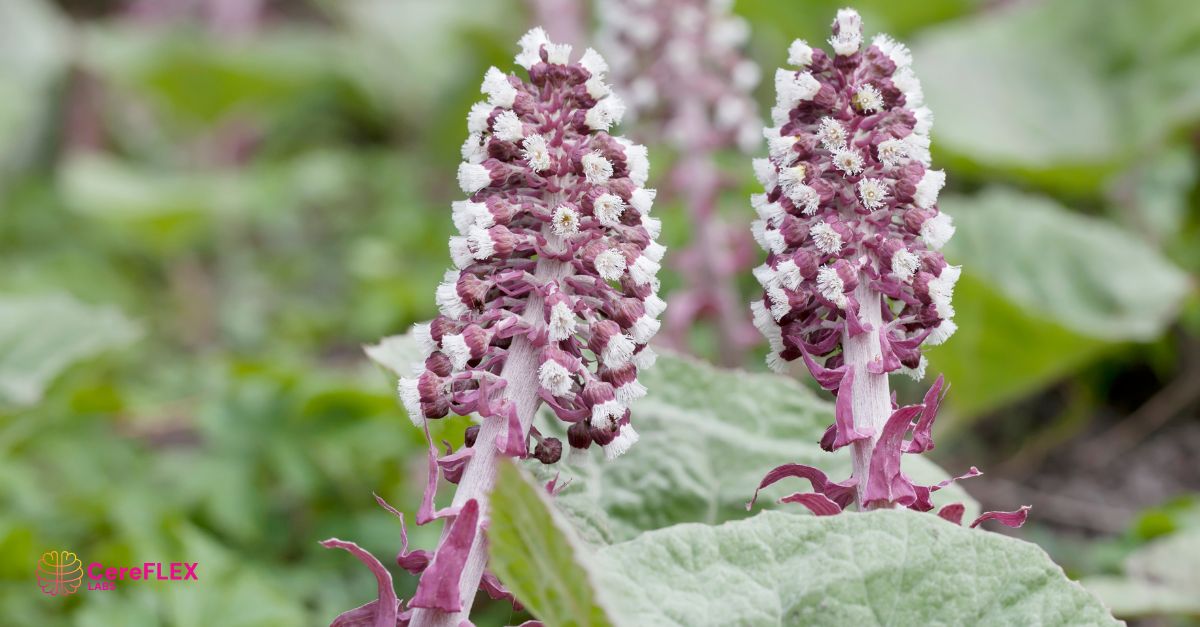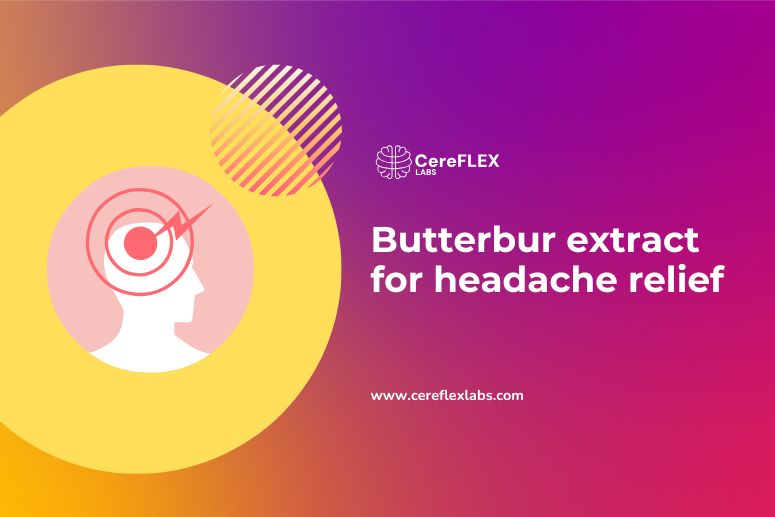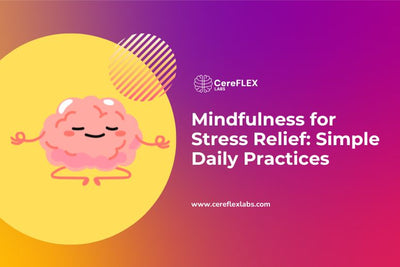If you’ve ever sat in a dark room, holding your head and waiting for the pain to ease, you’ve likely thought about natural alternatives. For some people, butterbur isn’t just another supplement—it’s one that has changed how often migraines strike.
Butterbur (Petasites hybridus) has a long history in European herbal medicine, but more recently, it's been studied in clinical trials for reducing migraine frequency. Unlike many so-called natural cures, butterbur has demonstrated results comparable to some prescription medications.
But it’s not risk-free. The same plant that may help relieve migraines can also cause liver damage if not carefully prepared.
This guide explains how butterbur works, what the science says, and how to use it safely—if at all.

What is butterbur?
Butterbur (Petasites hybridus) is a perennial plant found in damp areas across Europe, Asia, and North America. It’s known for its massive leaves—once used to wrap butter, giving the plant its name.
Despite its weedy appearance, butterbur contains compounds that have gained serious attention in migraine research.
Meet the Active Compounds: Petasin and Isopetasin
Butterbur’s medicinal effects come from two key molecules: petasin and isopetasin. These compounds act on multiple migraine-related pathways.
- Vasodilation: Petasins help relax constricted blood vessels by blocking L-type calcium channels. This reduces the muscle tension around blood vessels, easing one major migraine trigger.
- Inflammation control: They also inhibit COX-2 enzymes, reducing the production of prostaglandins—chemicals that drive inflammation and pain.
-
Pain signal modulation: Butterbur may also influence TRPA1 and TRPV1 ion channels, which are involved in nerve sensitivity. This could explain its broader effect on pain perception.
These combined actions make butterbur more than a folk remedy—it acts on blood vessels, inflammation, and pain signaling.
A Folk Remedy with Deep Roots
Long before clinical trials, butterbur was part of traditional herbal medicine. Healers used it to treat pain, asthma, digestive issues, and headaches.
Common preparations included teas and poultices. But these early methods didn’t remove pyrrolizidine alkaloids (PAs)—toxic compounds that occur naturally in raw butterbur and can damage the liver.
Modern extracts are safer but only when properly purified.

How does butterbur work?
Butterbur’s effect on migraines comes from its active compounds—primarily petasin and isopetasin. These natural molecules influence several processes involved in migraine development, including inflammation, blood vessel tone, and neuropeptide release.
Anti-Inflammatory Effects
Petasins help reduce inflammation by blocking key enzymes like cyclooxygenase (COX), lipoxygenase (LOX), and phospholipase A2. These enzymes produce inflammatory molecules that can trigger or worsen migraines.
Butterbur also desensitizes TRPA1 and TRPV1 ion channels, which are involved in transmitting pain signals in the nervous system. By dampening these signals, butterbur lowers how intensely the brain responds to triggers.
In addition, it suppresses the release of CGRP—a molecule linked to migraine pain and vascular changes. This multi-targeted action is what makes butterbur distinct from standard anti-inflammatories.
Clinical trials with PA-free butterbur root extract (e.g., Petadolex®) at 150 mg per day have shown a significant reduction in migraine frequency with no reported liver toxicity at therapeutic doses.1
CGRP Inhibition
Petasin and isopetasin directly reduce CGRP release from trigeminal nerve endings—one of the primary pathways involved in migraine pain and inflammation.
Animal studies found that when TRPA1 and TRPV1 receptors were activated using mustard oil or capsaicin, pre-treatment with petasins reduced CGRP levels in a dose-dependent manner. The effect was weaker in animals lacking these receptors, confirming the specific role of TRPA1/TRPV1 in this mechanism.2
This helps explain how butterbur reduces neurogenic inflammation and blood vessel dilation during migraines.

Calcium Channel Blocking
Another mechanism involves calcium channel modulation. Specifically, S-petasin helps relax smooth muscle in blood vessels by blocking L-type calcium channels. These channels normally allow calcium into muscle cells, causing them to contract and narrow the vessel.
By reducing calcium flow, butterbur encourages vasodilation, which supports improved blood flow and may reduce the likelihood of migraine onset.
Studies in animal models and isolated blood vessel tissues have confirmed that butterbur’s calcium-blocking effect is both dose-dependent and tissue-safe.3
Butterbur Dosage & Label Tips
When it comes to butterbur, the right dose—and the right product—makes all the difference.
Recommended Dosage
In clinical studies, adults typically used 75 mg twice daily of a standardized extract like Petadolex®, totalling 150 mg per day. This dose has been associated with fewer migraine attacks, shorter durations, and reduced severity—often cutting monthly attacks by nearly half.
Smaller or irregular doses are less likely to deliver consistent results. Talk to a healthcare provider before starting butterbur to confirm that it’s appropriate for you and to personalize your dosing plan.
Why Supplement Quality Matters
Butterbur isn’t like a multivitamin you can pick up anywhere. Some products still contain pyrrolizidine alkaloids (PAs)—toxins that can damage the liver and may be carcinogenic.
Only use products clearly labeled as “PA-free” or “pyrrolizidine alkaloid-free.” Even trace amounts of PAs are unsafe, so third-party testing and clear manufacturing standards are essential.
What to Look for on the Label
Choose butterbur supplements that:
- State “PA-free” clearly and prominently
- Include the name of the extract used (e.g., Petadolex)
- Provide dosing instructions aligned with clinical research (e.g., 75 mg per capsule)
- Mention third-party testing or list a contactable manufacturer
Red Flags to Avoid
Be cautious of products that:
- Use vague terms like “natural extract” with no PA removal details
- Offer low doses (e.g., 25 mg) without supporting evidence
- Omit manufacturing details or safety disclosures
Choosing a safe, research-backed product is just as important as taking the right dose.
How to Choose a Safe Butterbur Supplement
Not all butterbur products are created equal. In fact, some may do more harm than good.
The biggest concern? Pyrrolizidine alkaloids (PAs)—naturally occurring toxins found in raw butterbur. PAs can cause serious liver damage and have been linked to cancer in long-term exposure.
Choose Only “PA-Free” Products
Always look for butterbur supplements that are clearly labeled:
- “PA-free” or “pyrrolizidine alkaloid-free”
- Backed by third-party testing from reputable labs
- Produced by transparent manufacturers with contact information and clear quality disclosures
This isn’t just marketing. Even some trusted brands have been recalled due to PA contamination. Only buy products that explain how the PAs are removed.
Verify the Dosage
Safe and effective butterbur products typically use 75 mg per capsule—the amount shown to reduce migraine frequency in clinical trials. Anything below that may be ineffective. Anything unlabeled may be unsafe.
Avoid Products That…
❌ Use vague descriptions like “natural butterbur extract” without mentioning PA removal
❌ Offer low, unsupported doses (e.g., 25 mg)
❌ Omit manufacturing or testing details
A little label reading can go a long way toward protecting your health.

What are the side effects of butterbur?
Butterbur may help prevent migraines—but only when used carefully and in its purified form.
The primary concern is pyrrolizidine alkaloids (PAs), toxic compounds naturally found in raw butterbur. If not properly removed, they can cause liver damage and may increase the risk of cancer.
Even PA-free extracts aren’t risk-free. Some people may still experience mild side effects, especially during the first few weeks of use.
Common side effects may include:
- Belching or upset stomach
- Diarrhea
- Itchy or watery eyes
- Headaches
- Drowsiness or fatigue
- Shortness of breath
These effects tend to appear at standard doses—typically 75 mg twice daily—and may fade with continued use. If symptoms persist, lower the dose or stop use and consult a healthcare provider.
Who Should Avoid Butterbur?
❌ Pregnant or breastfeeding individuals: There’s not enough safety data, and any exposure to unfiltered PAs may pose risks to fetal development or nursing infants.
❌ People with liver conditions: Even PA-free butterbur has rare reports of hepatotoxicity. It’s best to avoid unless closely monitored by a physician.
❌ Anyone on multiple supplements or medications: Butterbur may interact with other compounds. Always consult your healthcare provider first.
Is butterbur safe for kids?
Butterbur may offer relief for children with migraines—but only in specific cases and under medical supervision.
Some studies suggest that PA-free butterbur extracts, such as Petadolex®, may be safe and effective for children aged 6 to 17 when used for short periods. In one clinical study, between 50% and 77% of participants reported fewer or less intense headaches after four months of use.4
Why Caution Still Matters
Children’s developing bodies may be more sensitive to herbal compounds. Even when labeled PA-free, butterbur supplements should never be given without consulting a paediatrician, especially one familiar with integrative or functional approaches.
Butterbur's potential benefits in kids come from its ability to:
- Reduce inflammation by lowering harmful molecules
- Decrease brain cell sensitivity involved in tension and migraine symptoms
- Improve blood flow, easing pressure in the head
While promising, these effects should always be weighed against potential risks.
Bottom Line
Butterbur may be useful in paediatric migraine management—but only with:
- PA-free certification
- Proper dosing guidance
- Short-term use (typically ≤ 4 months)
- Ongoing monitoring by a healthcare provider
Top 6 Evidence-Based Supplements for Migraine Relief
Butterbur is just one of several nutraceuticals shown to reduce migraine frequency and severity. Below is a comparison of six well-researched supplements. Each offers a different mechanism of action—and different safety considerations.
Use this table to guide a discussion with your healthcare provider.
Migraine Supplement Comparison |
||||
|---|---|---|---|---|
|
Supplement |
Dosage |
Common Side Effects |
Key Risk |
Primary Mechanism |
|
Butterbur |
75 Mg Twice Daily (150 Mg) |
Upset Stomach, Fatigue |
Liver Toxicity Risk—Only Use PA-Free |
Anti-Inflammatory; CGRP Inhibition; Vasodilation |
|
Riboflavin (B2) |
400 Mg/Day |
Diarrhea, Orange Urine |
Generally Safe |
Supports Mitochondrial Energy Production |
|
Coenzyme Q10 |
300 Mg/Day |
Mild Insomnia, Digestive Upset |
Low Risk |
Antioxidant; Reduces Oxidative Stress |
|
Magnesium (Citrate) |
600 Mg/Day |
Diarrhea, Cramping |
GI Upset at High Doses |
Corrects Deficiency Linked to Migraine Susceptibility |
|
Melatonin |
3–4 Mg/Day |
Sleepiness, Dizziness |
Occasional Allergic Reactions |
Regulates Brain Neurotransmitters and Sleep-Wake Cycles |
|
Omega-3 Fatty Acids |
≥1,500 Mg/Day (EPA/DHA) |
Bleeding Risk at High Doses |
Immune Suppression in Excess |
Anti-Inflammatory; May Reduce Attack Frequency/Severity |
Optimize Migraine Prevention with Full Cognitive Support
While butterbur and other supplements can help reduce migraine frequency, long-term brain health often requires more comprehensive support.
That’s where full-spectrum cognitive formulations come in. For individuals navigating both migraines and mental fatigue, daily support for focus, neurotransmitter balance, and stress resilience can make a meaningful difference.
CereFLEX Labs offers a two-part protocol designed to complement migraine management:
- AM Formula: Supports mental energy, attention span, and working memory—ideal for mornings when brain fog hits hardest.
-
PM Formula: Helps calm the nervous system, reduce oxidative stress, and support restorative rest.
These formulas are well-suited for adults with high cognitive demands, including professionals, athletes, and those managing recurring neurological symptoms.
Used alongside targeted nutraceuticals like butterbur or magnesium, nootropics for clarity and focus can help maintain overall brain balance and resilience. Some people may also benefit from nootropics to enhance mental resilience during periods of chronic stress or disrupted sleep.
As always, consult your healthcare provider to determine what combination of supplements is appropriate for your needs.
Conclusion
Migraines are more than just headaches. They interfere with your focus, energy, and ability to function—often without warning. For those seeking a natural, research-backed option, butterbur has shown promise in reducing the number and severity of migraine attacks.
But effectiveness depends on quality and safety. Only use PA-free products, follow evidence-based dosages, and consult a healthcare provider—especially if you have liver concerns or are considering it for a child.
Managing migraines isn’t just about stopping one attack. It’s about supporting the brain long-term—through lifestyle habits, sleep hygiene, and targeted supplements. Strategies like consistent dosing of safe butterbur, magnesium, or [caffeine-free nootropics] may help reduce the burden of migraines over time.
Smart, steady brain support makes a difference.






